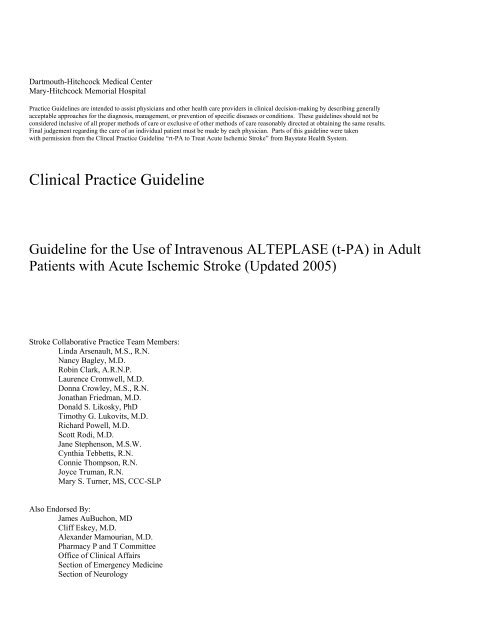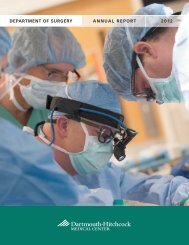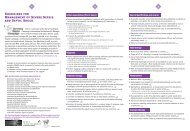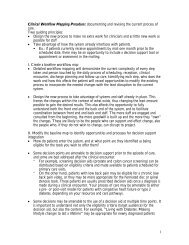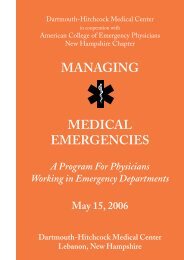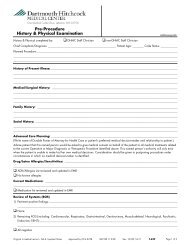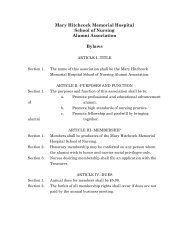Guideline for the Use of Intravenous ALTEPLASE (t-PA)
Guideline for the Use of Intravenous ALTEPLASE (t-PA)
Guideline for the Use of Intravenous ALTEPLASE (t-PA)
Create successful ePaper yourself
Turn your PDF publications into a flip-book with our unique Google optimized e-Paper software.
Dartmouth-Hitchcock Medical CenterMary-Hitchcock Memorial HospitalPractice <strong>Guideline</strong>s are intended to assist physicians and o<strong>the</strong>r health care providers in clinical decision-making by describing generallyacceptable approaches <strong>for</strong> <strong>the</strong> diagnosis, management, or prevention <strong>of</strong> specific diseases or conditions. These guidelines should not beconsidered inclusive <strong>of</strong> all proper methods <strong>of</strong> care or exclusive <strong>of</strong> o<strong>the</strong>r methods <strong>of</strong> care reasonably directed at obtaining <strong>the</strong> same results.Final judgement regarding <strong>the</strong> care <strong>of</strong> an individual patient must be made by each physician. Parts <strong>of</strong> this guideline were takenwith permission from <strong>the</strong> Clincal Practice <strong>Guideline</strong> “rt-<strong>PA</strong> to Treat Acute Ischemic Stroke” from Baystate Health System.Clinical Practice <strong>Guideline</strong><strong>Guideline</strong> <strong>for</strong> <strong>the</strong> <strong>Use</strong> <strong>of</strong> <strong>Intravenous</strong> <strong>ALTEPLASE</strong> (t-<strong>PA</strong>) in AdultPatients with Acute Ischemic Stroke (Updated 2005)Stroke Collaborative Practice Team Members:Linda Arsenault, M.S., R.N.Nancy Bagley, M.D.Robin Clark, A.R.N.P.Laurence Cromwell, M.D.Donna Crowley, M.S., R.N.Jonathan Friedman, M.D.Donald S. Likosky, PhDTimothy G. Lukovits, M.D.Richard Powell, M.D.Scott Rodi, M.D.Jane Stephenson, M.S.W.Cynthia Tebbetts, R.N.Connie Thompson, R.N.Joyce Truman, R.N.Mary S. Turner, MS, CCC-SL<strong>PA</strong>lso Endorsed By:James AuBuchon, MDCliff Eskey, M.D.Alexander Mamourian, M.D.Pharmacy P and T CommitteeOffice <strong>of</strong> Clinical AffairsSection <strong>of</strong> Emergency MedicineSection <strong>of</strong> Neurology
IntroductionIn 1996, <strong>the</strong> Food and Drug Administration (FDA) approved <strong>the</strong> use <strong>of</strong> <strong>ALTEPLASE</strong> (t-<strong>PA</strong>) <strong>for</strong> acute ischemic stroke after <strong>the</strong>report <strong>of</strong> a randomized, two-part trial sponsored by <strong>the</strong> National Institute <strong>of</strong> Neurological Disorders and Stroke (NINDS) 1 . Thecommittees <strong>of</strong> <strong>the</strong> American Heart Association (AHA) 2,4 and <strong>the</strong> American Academy <strong>of</strong> Neurology (AAN) 3 <strong>the</strong>n published guidelinesendorsing <strong>the</strong> use <strong>of</strong> <strong>ALTEPLASE</strong> t-<strong>PA</strong> <strong>for</strong> acute ischemic stroke under strict inclusion and exclusion criteria. The enclosed practiceguideline and order set are based on <strong>the</strong> NINDS rt-<strong>PA</strong> Stroke Study and <strong>the</strong> AHA and AAN guidelines and will allow <strong>for</strong> optimal patientselection and management. This practice guideline was reviewed and minor revisions were made in 2005. The update includes <strong>the</strong> use <strong>of</strong>Nicardipine <strong>for</strong> blood pressure control.Key Points• The FDA has approved <strong>the</strong> use <strong>of</strong> <strong>ALTEPLASE</strong> (t-<strong>PA</strong>) <strong>for</strong> acute ischemic stroke following <strong>the</strong> report <strong>of</strong> a randomized two partclinical trial sponsored by <strong>the</strong> National Institute <strong>of</strong> Neurologic Disorders and Stroke (NINDS). The American Heart Association and<strong>the</strong> American Academy <strong>of</strong> Neurology have also endorsed <strong>the</strong> use <strong>of</strong> <strong>ALTEPLASE</strong> t-<strong>PA</strong> under strict inclusion and exclusion criteria.• The use <strong>of</strong> <strong>ALTEPLASE</strong> (t-<strong>PA</strong>) <strong>for</strong> acute ischemic stroke resulted in a significant improvement in NIH Stoke Scale within <strong>the</strong> first 24hours as well as neurologic and functional outcomes at three months if administered within 3 hours <strong>of</strong> stroke onset. Significantlymore patients had complete recovery at three months who were treated with t-<strong>PA</strong> than placebo. These outcomes were at <strong>the</strong> expense<strong>of</strong> an increase in symptomatic intracerebral hemorrhages within 36 hours <strong>of</strong> <strong>the</strong> onset <strong>of</strong> stroke. However, in <strong>the</strong> patients whoexperienced intra-cerebral hemorrhages post <strong>ALTEPLASE</strong> (t-<strong>PA</strong>) infusion, <strong>the</strong> majority <strong>of</strong> hemorrhages occurred in patients wi<strong>the</strong>xtremely severe strokes.• Determination <strong>of</strong> appropriate patients <strong>for</strong> candidacy <strong>for</strong> <strong>ALTEPLASE</strong> (t-<strong>PA</strong>) is based on well researched inclusion and exclusioncriteria. Assessment <strong>of</strong> each patient considered <strong>for</strong> <strong>ALTEPLASE</strong> (t-<strong>PA</strong>) administration will be done by a physician. Minimuminclusion criteria are:• symptom onset less than 180 minutes• patient is > 18 years <strong>of</strong> age• clinical diagnosis <strong>of</strong> ischemic stroke causing a measurable neurological deficit• patient/family are in<strong>for</strong>med <strong>of</strong> possible benefits and risk <strong>of</strong> t-<strong>PA</strong>.• Coordination <strong>of</strong> <strong>the</strong> acute stroke response team is critical to success. Each team member is responsible <strong>for</strong> a designated component <strong>of</strong>care. The Emergency Medical System (EMS) and Emergency Department Staff will identify potential candidates and begin <strong>the</strong>determination process. Neurologists, who are part <strong>of</strong> an Acute Stroke Response Team, will respond immediately to consult on apotential candidate. CT scan will be done and reviewed by <strong>the</strong> Radiologist as soon as possible.• Once <strong>the</strong> decision to treat is made, <strong>the</strong> <strong>ALTEPLASE</strong> (t-<strong>PA</strong>) order sets will be implemented. The order sets provide recommendations<strong>for</strong>: <strong>ALTEPLASE</strong> (t-<strong>PA</strong>) drug dosage, management <strong>of</strong> hypertension, monitoring parameters, additional diagnostics, treating ableeding event, care <strong>of</strong> <strong>the</strong> patient receiving <strong>ALTEPLASE</strong> (t-<strong>PA</strong>) and care <strong>of</strong> <strong>the</strong> patient post <strong>ALTEPLASE</strong> (t-<strong>PA</strong>) infusion.• Recent data now suggests initial hospitalization <strong>of</strong> patients treated with <strong>ALTEPLASE</strong> (t-<strong>PA</strong>) is shorter than patients not treated with<strong>ALTEPLASE</strong> (t-<strong>PA</strong>). Also more patients treated with <strong>ALTEPLASE</strong> (t-<strong>PA</strong>) were discharged to home and required less inpatientrehabilitation and nursing home care.Minimum Inclusion Criteria For IV Treatment With <strong>ALTEPLASE</strong> (t-<strong>PA</strong>)Caveat: Caution in differential diagnosis (exclude migraine, Bell’s Palsy, Todd’s post-ictal paralysis, TIA, giant cell arteritis/vasculitis, etc.).• Age > 18 years.• Clinical diagnosis <strong>of</strong> acute ischemic stroke causing a measurable neurological deficit.• Time <strong>of</strong> symptom onset well established to be less than 180 minutes be<strong>for</strong>e infusion would begin. Patients thus awakening withstroke are generally ineligible.• Potential benefits and risks discussed with patient, family, and/or legal guardian be<strong>for</strong>e treatment begun.c:ms<strong>of</strong>fice\winword\guidelines\tpa
Exclusion Criteria• Only minor or rapidly improving stroke symptoms. Examples <strong>of</strong> such exclusions are: ataxia alone; sensory loss alone; dysarthria alone;minimal weakness.• Evidence <strong>of</strong> intracranial or subarachnoid hemorrhage on pretreatment Computerized Axial Tomography (CT).• Clinical presentation suggestive <strong>of</strong> subarachnoid hemorrhage, even with normal CT.• Awakening with stroke and > 3 hours has past since patient last seen at baseline.• Active internal bleeding.• History <strong>of</strong> intracranial hemorrhage.• Known bleeding dia<strong>the</strong>sis, including but not limited to:• Platelet count 1.5.*In patients without recent use <strong>of</strong> oral anticoagulants or heparin, treatment with <strong>ALTEPLASE</strong> (t-<strong>PA</strong>) can be initiated prior to <strong>the</strong>availability <strong>of</strong> coagulation results but should be discontinued if ei<strong>the</strong>r <strong>the</strong> INR is greater than 1.7 or <strong>the</strong> aPTT is elevated.• Current pregnancy.• Within 3 months any intracranial surgery, serious head trauma, or previous stroke.• Major surgery or truncal trauma within <strong>the</strong> preceding 14 days.• History <strong>of</strong> gastrointestinal or urinary tract hemorrhage within 21 days.• Recent arterial puncture at a noncompressible site.• Recent lumbar puncture.• On repeated measurements, systolic blood pressure greater than 185 mm Hg or diastolic blood pressure greater than 110 mm Hg at<strong>the</strong> time treatment is to begin and patient requires aggressive treatment to reduce blood pressure to within <strong>the</strong>se limits.• Abnormal blood glucose (< 50 or > 400 mg/dL).• Post-myocardial infarction pericarditis.• Seizure near <strong>the</strong> time <strong>of</strong> onset <strong>of</strong> stroke symptoms.• History <strong>of</strong> severe dementia or severe pre-existing neurologic impairment.Note: Current or recent use <strong>of</strong> aspirin, ticlopidine, or clopidogrel is not a contraindication.Warnings/Relative Contraindications• Age > 85 years• Severe neurologic deficit (e.g., National Institutes <strong>of</strong> Health Stroke Scale Score > 20).• Baseline CT scan evidence <strong>of</strong> extensive ischemic changes. This includes early evidence <strong>of</strong> sulcal effacement, herniation, mass effect, oredema.• Recent myocardial infarction (given risk <strong>of</strong> post-myocardial infarction pericarditis and LV thromboembolism), recent dysfunctionaluterine bleeding, or active menstruation.c:ms<strong>of</strong>fice\winword\guidelines\tpa
Treatment• <strong>ALTEPLASE</strong> (t<strong>PA</strong>) 0.9 mg/kg (maximum <strong>of</strong> 90 mg) infused over 60 minutes with 10% <strong>of</strong> <strong>the</strong> total dose administered as an initialintravenous bolus over 1 minute.Protocol <strong>for</strong> Activating a Stroke Alert and Paging <strong>the</strong> Acute Stroke Response Team• Upon notification by EMS personnel that an incoming stroke patient meets specific criteria, as outlined in this protocol, <strong>the</strong> ED willcall <strong>the</strong> operator to initiate a STROKE ALERT and <strong>the</strong> stroke team members will be paged with <strong>the</strong> text “STROKE ALERT” and <strong>the</strong>estimated time <strong>of</strong> arrival. For patients arriving to <strong>the</strong> ED by car or <strong>for</strong> patients with in-hospital stroke, <strong>the</strong> ED or treating hospitalphysician will determine if <strong>the</strong> patient meets specific criteria, as outlined in this protocol, and call a STROKE ALERT. Upon receipt<strong>of</strong> page, appropriate team members will promptly respond to <strong>the</strong> emergency department to evaluate <strong>the</strong> patient.Criteria <strong>for</strong> ED to call a STROKE ALERT <strong>for</strong> patients being transported by EMS:1. EMS is transporting a patient with a suspected acute stroke (symptoms include sudden numbness, weakness or paralysis <strong>of</strong> face, armor leg - especially on one side <strong>of</strong> <strong>the</strong> body; sudden confusion, trouble speaking or understanding speech; sudden trouble seeing in oneor both eyes; sudden trouble walking, dizziness, loss <strong>of</strong> balance or coordination; or sudden severe headache with no known cause)2. Symptom onset less than 5 hours [N.B. IV <strong>ALTEPLASE</strong> (t-<strong>PA</strong>) is approved only <strong>for</strong> treatment within 3 hours <strong>of</strong> symptom onset].3. Age greater than or equal to 18 years4. Blood glucose is 50-400 mg/dL or is not available.5. No severe trauma or witnessed seizure6. Positive Cincinnati Stroke Scale obtained by EMS (facial droop, arm drift or abnormal speech)Criteria <strong>for</strong> calling a STROKE ALERT <strong>for</strong> patients who come to ED by car or <strong>for</strong> patients with in-hospital stroke1. Suspected acute stroke (symptoms include sudden numbness, weakness or paralysis <strong>of</strong> face, arm or leg - especially on one side <strong>of</strong> <strong>the</strong>body; sudden confusion, trouble speaking or understanding speech; sudden trouble seeing in one or both eyes; sudden troublewalking, dizziness, loss <strong>of</strong> balance or coordination; or sudden severe headache with no known cause)2. Symptom onset less than 5 hours [N.B. IV <strong>ALTEPLASE</strong> (t-<strong>PA</strong>) is approved only <strong>for</strong> treatment within 3 hours <strong>of</strong> symptom onset].3. Age greater than or equal to 18 years4. Blood glucose is 50-400 mg/dL or is not available.5. No severe trauma or witnessed seizure6. Positive Cincinnati Stroke Scale obtained by ED or o<strong>the</strong>r hospital staff (facial droop, arm drift or abnormal speech).To Respond:1. Neurology resident covering <strong>the</strong> ED2. Stroke Center Co-Director and Nurse Practitioner (if available in house): Timothy Lukovits, M.D., pager 2410 and Robin Clark,A.R.N.P., pager 4440.*If team does not respond by phone or in-person within 10 minutes, have Operator repeat stroke alert page.c:ms<strong>of</strong>fice\winword\guidelines\tpa
Sequence Of Events• Determine whe<strong>the</strong>r timing allows treatment initiation with <strong>ALTEPLASE</strong> (t-<strong>PA</strong>) be<strong>for</strong>e <strong>the</strong> three-hour limit.• Activate Stroke Alert if above criteria are met AND <strong>PA</strong>GE Neurology Resident on call <strong>for</strong> ED.• Draw blood <strong>for</strong> tests while preparations are made to per<strong>for</strong>m non-contrast CT scan.• Start recording blood pressure, pulse rate, oxygen saturation, respiratory rate and temperature.• Neurological examination (NIHSS score).• CT scan without contrast.• Determine if CT has evidence <strong>of</strong> hemorrhage.• If patient has severe head or neck pain, or is somnolent or stuporous, be sure <strong>the</strong>re is no evidence <strong>of</strong> subarachnoid hemorrhage.• If <strong>the</strong>re is a significant abnormal lucency suggestive <strong>of</strong> infarction, reconsider <strong>the</strong> patient's history, since <strong>the</strong> stroke may have occurredearlier.• Review required test results:• Platelet count.• Blood glucose.• PT or aPTT (in patients with recent use <strong>of</strong> oral anticoagulants or heparin).• Review patient inclusion and exclusion criteria.• Infuse ALTEPLSAE (t-<strong>PA</strong>): Give a total <strong>of</strong> 0.9 mg/kg over 60 minutes, starting with 10% as a bolus over one minute intravenously.Maximum total dose =90mg. See dosing sheet.• Do not give aspirin, ticlopidine, clopidogrel, glycoprotein IIB/IIIA agents, heparin in any <strong>for</strong>m or warfarin <strong>for</strong> 24 hours.• Monitor <strong>the</strong> patient carefully, especially <strong>the</strong> blood pressure. Follow <strong>the</strong> blood pressure algorithm (see below orders).• Monitor neurological status (see below orders).Adjunctive TherapyBleeding Precautions• No concomitant antithrombotic or antiplatelet <strong>the</strong>rapy during <strong>the</strong> first 24 hours after symptom onset. If heparin or any o<strong>the</strong>ranticoagulant is indicated after 24 hours, consider per<strong>for</strong>ming a non-contrast CT scan or o<strong>the</strong>r sensitive diagnostic imaging method torule out any hemorrhage be<strong>for</strong>e starting an anticoagulant.• Restrict central venous access and arterial punctures during first 24 hours.• Avoid inserting indwelling bladder ca<strong>the</strong>ter during infusion and <strong>for</strong> 30 minutes after <strong>ALTEPLASE</strong> (t-<strong>PA</strong>) infusion ends.Blood Pressure Control (excessively high blood pressure might increase bleeding risk while extensively low blood pressure mayexacerbate ischemic symptoms):• Pretreatment• Monitor blood pressure every 15 minutes. It should be below 185/110 mm/hg be<strong>for</strong>e initiating t-<strong>PA</strong>.• During and after treatment: Monitor blood pressure <strong>for</strong> <strong>the</strong> first 24 hours after starting treatment:• every 15 minutes <strong>for</strong> 2 hours after starting <strong>the</strong> infusion, <strong>the</strong>n• every 30 minutes <strong>for</strong> 6 hours, <strong>the</strong>n every hour <strong>for</strong> 18 hours, and <strong>the</strong>n q 4 hours <strong>for</strong> 24 hours, <strong>the</strong>n per routine.• If systolic BP is > or equal to 180 mm Hg or if diastolic BP is 105 to 140 mm Hg on two successive readings 5 to 10 minutesapart, give labetalol 10 mg IV over 2 minutes. The dose may be repeated or doubled every 10 to 20 minutes, up to 300 mg.c:ms<strong>of</strong>fice\winword\guidelines\tpa
Alternatively, following <strong>the</strong> first bolus <strong>of</strong> labetalol, an IV infusion <strong>of</strong> 0.5-2 mg/min <strong>of</strong> labetalol may be initiated and continueduntil <strong>the</strong> desired blood pressure is reached. Monitor <strong>for</strong> hypotension.• If systolic BP is persistently > 180 mm Hg despite labetalol, start an intravenous infusion <strong>of</strong> Nicardipine,. Start at 5mg/hour andtitrate to maintain SBP less than 180 and DPB less than 105 by increasing infusion rate by 2.5 mg/hour every 5 minutes to amaximum <strong>of</strong> 15 mg/hour. Frequent BP measurements (every 15 minutes) are recommended <strong>for</strong> 1 hour after initiation<strong>of</strong> <strong>the</strong> Nicardipine infusion and after a dose change, <strong>the</strong>n every 30 minutes.. Monitor <strong>for</strong> hypotension.• If systolic BP is persistently > 180 mm Hg despite labetalol and Nicardipine or if diastolic BP > 140 mm Hg on two successivereadings 5-10 minutes apart, start an intravenous infusion <strong>of</strong> sodium nitroprusside, 0.5 to 10 micrograms/kg/min. Weighbenefits/risks <strong>of</strong> indwelling A-line. Monitor <strong>for</strong> hypotension.• Monitor <strong>for</strong> severe headache; neck pain/rigidity; decline or abrupt change in mental status; HR 120 bpm; acceleratingBP; nausea/ vomiting; seizure activity; caudal progression <strong>of</strong> respirations; muscle tone; decerebrate/decorticate posturing; "blownpupil" or o<strong>the</strong>r deteriorating neurological signs: report STAT to M.D. This may indicate intracranial hemorrhage.• If an intracranial hemorrhage is suspected, <strong>the</strong> administration <strong>of</strong> <strong>ALTEPLASE</strong> (t-<strong>PA</strong>) should be immediately discontinued and anemergency CT scan should be obtained.Management <strong>of</strong> Intracranial Hemorrhage or O<strong>the</strong>r Major Bleeding Complication:• Suspect <strong>the</strong> occurrence <strong>of</strong> intracranial hemorrhage following <strong>the</strong> start <strong>of</strong> <strong>ALTEPLASE</strong> (t-<strong>PA</strong>) infusion if <strong>the</strong>re is any subsequentneurological deterioration, change in seizure pattern, new or severe exacerbation <strong>of</strong> headache, brady- or tachycardia, acutehypertension or o<strong>the</strong>r sudden change in vital signs including respiratory pattern, muscle tone, decerebrate/decorticate posturing, oronset <strong>of</strong> nausea and vomiting.• If hemorrhage is suspected:• Discontinue ALTEPLSAE (t-<strong>PA</strong>) infusion unless o<strong>the</strong>r causes <strong>of</strong> neurological deterioration are apparent.• Immediate CT scan to check <strong>for</strong> presence <strong>of</strong> hemorrhage.• Draw blood <strong>for</strong> Hct/Hgb, PT, aPTT, platelet count, fibrinogen and type and cross.• Prepare <strong>for</strong> administration <strong>of</strong> plasma and/or cryoprecipitate if clinically significant abnormalities in coagulation screeningtests are found.Dosage should be based on extent <strong>of</strong> abnormality and blood volume. Usual (initial) dosage <strong>of</strong> plasma is 10-20 mL/kg; additional doses may be necessarydepending on extent <strong>of</strong> deficiency. Cryoprecipitate is indicated <strong>for</strong> <strong>the</strong> replenishment <strong>of</strong> fibrinogen; <strong>the</strong> usual target is 200 mg/dL. If <strong>the</strong> patient is deficient in FactorVIII, virally inactivated Antihemophilic Factor is indicated; <strong>the</strong> usual target is 100% activity. The blood bank will calculate and send <strong>the</strong> appropriate volume <strong>of</strong>plasma and/or cryoprecipitate based on <strong>the</strong> patient's weight.• Prepare <strong>for</strong> administration <strong>of</strong> platelets.Dosage depends on extent <strong>of</strong> thrombocytopenia, content <strong>of</strong> unit(s), and size <strong>of</strong> patient. Usual (initial) dose is one unit <strong>of</strong> Platelets, Pheresis or 4-8 units <strong>of</strong> plateletconcentrate. The platelet count should be raised to 50-100,000/uL through transfusion(s).• Prepare <strong>for</strong> <strong>the</strong> administration <strong>of</strong> Red Blood Cells.Transfusion <strong>of</strong> red cells is not likely to be necessary unless bleeding develops at extracranial sites or evacuation surgical <strong>of</strong> <strong>the</strong> intracranial hemorrhage is necessary.The dosage will depend on <strong>the</strong> patient's co-morbidities, symptomatology and initial hemoglobin concentration. Volume resuscitation should be attempted be<strong>for</strong>edeciding whe<strong>the</strong>r transfusion is required.• If intracranial hemorrhage present:• STAT neurosurgery consult.• STAT hematology consult.• Second CT to assess progression <strong>of</strong> intracranial hemorrhage when appropriate.c:ms<strong>of</strong>fice\winword\guidelines\tpa
References1. The National Institute <strong>of</strong> Neurological Disorders and Stroke rt-<strong>PA</strong> Stroke Study Group. Tissueplasminogen activator <strong>for</strong> acute ischemic stroke. The New England Journal <strong>of</strong> Medicine. 1995; 333:1581-7.2. Adams HP Jr, Brott TG, Furlan AJ, et al. <strong>Guideline</strong>s <strong>for</strong> thrombolytic <strong>the</strong>rapy <strong>for</strong> acute stroke: Asupplement to <strong>the</strong> guidelines <strong>for</strong> <strong>the</strong> management <strong>of</strong> patients with acute ischemic stroke: A statement <strong>for</strong>healthcare pr<strong>of</strong>essionals from a special writing group <strong>of</strong> <strong>the</strong> Stroke Council, American Heart Association.Stroke. 1996; 27:1711-8.3. Practice advisory: Thrombolytic <strong>the</strong>rapy <strong>for</strong> acute ischemic stroke - Summary statement: Report <strong>of</strong> <strong>the</strong>Quality Standards Subcommittee <strong>of</strong> <strong>the</strong> American Academy <strong>of</strong> Neurology. Neurology. 1996; 47:835-9.4. Adams, HP Jr, Adams RJ, Brott T, et al. <strong>Guideline</strong>s <strong>for</strong> <strong>the</strong> Early Management <strong>of</strong> Patients WithIschemic Stroke. A Scientific Statement From <strong>the</strong> Stroke Council <strong>of</strong> <strong>the</strong> American Stroke Association.Stroke 2003; 34:1056-1083.c:ms<strong>of</strong>fice\winword\guidelines\tpa


